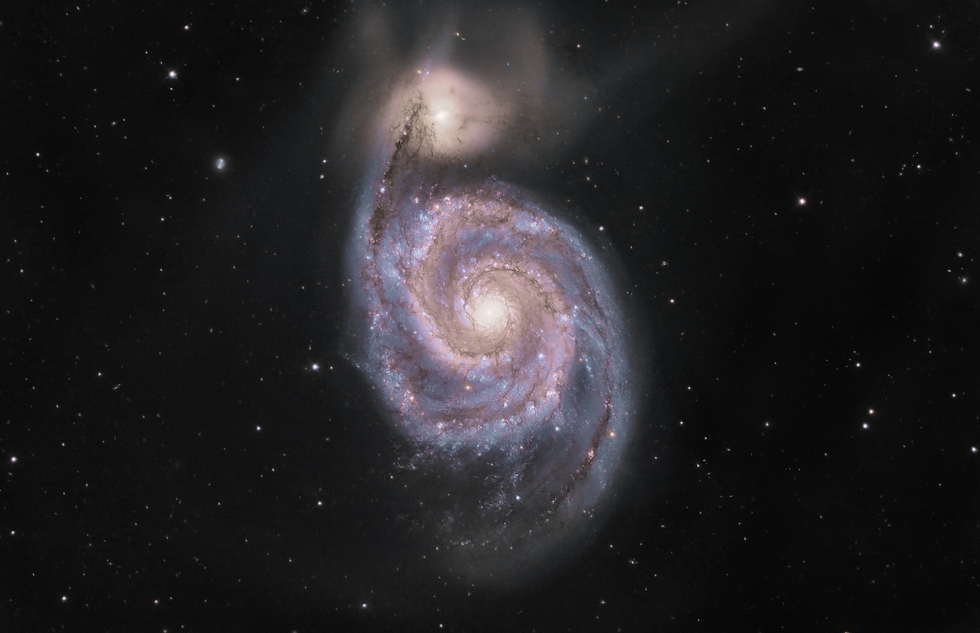The Whirlpool Galaxy (Whirlpool Galaxy), also known as Messier 51a (M51a), is a distinctly structured spiral galaxy. Although it resembles the Milky Way in structure, it is one of the few external galaxies that can be observed relatively easily and whose structural features can be clearly distinguished.

Location of Messier 51. (NASA)
First observed in 1773 by Charles Messier, M51 entered the history of science as one of the first examples demonstrating the existence of spiral galaxies, particularly through the drawings made by Lord Rosse in the 19th century.
General Features
- Name: Whirlpool Galaxy
- Catalog Name: Messier 51a (M51a), NGC 5194
- Location: Canes Venatici Constellation
- Distance: Approximately 23 million light-years (7 megaparsecs)
- Diameter: Approximately 76,000 light-years
- Apparent Magnitude: +8.4
- Type: SA(s)bc (unbarred spiral galaxy)
- Satellite Galaxy: NGC 5195 (M51b)
Structure and Components
Spiral Arms
The Whirlpool Galaxy has distinctly symmetrical spiral arms. These arms are composed of stars, dust, and gas, and contain regions of intense star formation. Due to differential rotation, the spiral arms twist over time, and the gas clouds within them condense, turning into star-forming regions.

Whirlpool Galaxy. (Telescope Lİve)
Nucleus and Central Region
At the galaxy’s center lies a bright core, likely hosting a supermassive black hole. Observations by the Hubble Space Telescope (HST) have provided weak signs of active galactic nucleus (AGN)-like emissions. However, compared to typical AGNs, M51a has a relatively low-activity central structure.
Satellite Galaxy: NGC 5195
The small galaxy NGC 5195 (M51b), located northeast of M51, is physically interacting with M51a. This interaction has strengthened the structure of the spiral arms and increased the rate of star formation in the galaxy. Numerical simulations show that NGC 5195 has orbited M51a once and is currently making its second close pass.
Star Formation and Galactic Evolution
The Whirlpool Galaxy is an extremely active system in terms of star formation. Especially along the spiral arms, H-II regions have been observed. These regions are identified by ionized hydrogen gas surrounding high-mass young stars.
Star formation was triggered as a result of the gravitational interaction between M51a and NGC 5195. This process altered the evolutionary dynamics of the galaxy, making it a cosmologically significant subject of study.
Observational Studies
M51 has been observed across numerous ranges of the electromagnetic spectrum:
- Optical: High-resolution images provided by the Hubble Space Telescope have revealed the details of the spiral structure.
- Radio: Observations by the Karl G. Jansky Very Large Array (VLA) have mapped the distribution of neutral hydrogen in the galaxy.
- X-rays: The Chandra X-ray Observatory has detected low-level X-ray emissions from the black hole at the center.
- Infrared: The Spitzer Space Telescope has provided data on the dusty star-forming regions.
Numerical Simulations and Theoretical Models
The M51 system is frequently used in numerical simulations of galaxy collisions and interactions. The classic simulations by Toomre were particularly effective in demonstrating the impact of galaxy interactions on the formation of spiral structures. Current models show that galactic interactions affect not only morphology but also chemical evolution in significant ways.
Scientific and Cosmological Importance
The Whirlpool Galaxy is a key example for understanding spiral galaxy structures and galactic interactions in the universe. It also serves as an observational laboratory for studying star formation regions, gas distribution, core activity, and galaxy evolution. In this regard, it is a major point of interest for both amateur astronomers and professional scientists.
M51, the Whirlpool Galaxy, stands out as a crucial observational target for understanding astrophysical processes. With its symmetrical spiral structure, interaction with its satellite galaxy, star-forming regions, and multi-wavelength observational data, it is a fundamental object of study in the fields of galaxy evolution and morphology.


